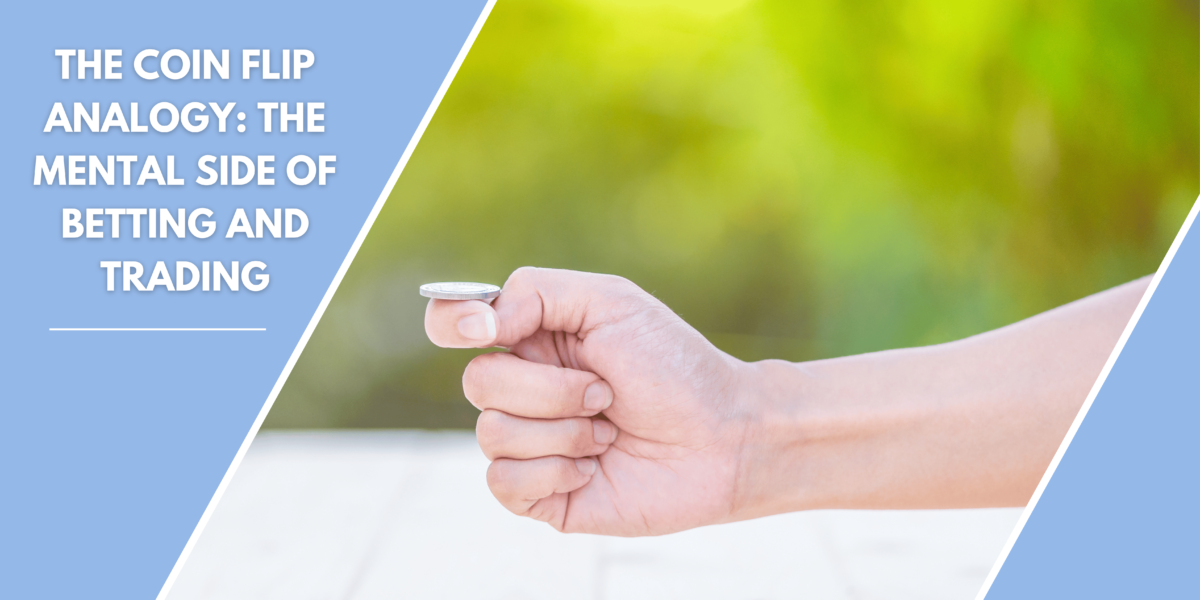In the world of gambling and financial trading, making consistent profits is the ultimate goal. To achieve this, professionals often employ various strategies and tactics, but one often overlooked aspect is the mental side of betting and trading.
Understanding the psychology behind decision-making and embracing a long-term perspective can significantly improve one’s chances of success. A simple coin flip serves as an insightful analogy, reminding us to view bets and trades as part of a larger sequence rather than isolated events.
The Coin Flip Analogy
When flipping a fair coin, the outcome is inherently random, with a 50% chance of landing on heads and a 50% chance of landing on tails. Each individual flip is independent of the previous one, and no matter the outcome, the probabilities remain the same for subsequent flips. Similarly, in betting or trading, each individual bet or trade may yield a win or a loss, but the key lies in evaluating the overall sequence of bets or trades.
Looking at the Sequence
Rather than focusing solely on the outcome of a single bet or trade, successful bettors and traders analyse the entire sequence of their actions. They understand that short-term results can be influenced by randomness and variance, but the long-term outcome tends to converge toward the true probabilities and expected value.
Expected Value and Probabilities
In betting and trading, expected value (EV) is a crucial concept. It represents the average value one can expect to gain or lose from a particular bet or trade over the long run. To calculate the EV, one needs to consider both the potential gains and losses, as well as the associated probabilities.
By understanding the concept of EV, individuals can make informed decisions and identify favorable opportunities that offer positive expected value. It allows them to make rational choices, even in the face of short-term losses or setbacks.
An Example
Let’s consider an example using the coin flip analogy and expected value.
Imagine a scenario where you have the opportunity to bet on a fair coin flip. If the coin lands on heads, you win $10, and if it lands on tails, you lose $5.
To calculate the expected value (EV) of this bet, we need to consider the potential outcomes and their probabilities. Since the coin is fair, the probability of heads is 0.5 (50%) and the probability of tails is also 0.5 (50%).
Now let’s calculate the expected value:
EV = (Probability of Heads x Value of Heads) + (Probability of Tails x Value of Tails)
EV = (0.5 x $10) + (0.5 x -$5)
EV = $5 + (-$2.5)
EV = $2.5
The expected value of this bet is $2.5. This means that, on average, you can expect to gain $2.5 for each coin flip in the long run.
Now, even though each individual coin flip may result in a win or a loss, the key is to focus on the expected value over a sequence of flips. If you were to make 100 bets using the same odds, your expected value would be $2.5 per flip, and you could expect to make a profit of around $250 over the long run.
Understanding expected value helps you make informed decisions. In this example, since the expected value is positive, it indicates that the bet has favorable odds, and over time, you should come out ahead. However, it’s important to remember that short-term results can still be influenced by randomness, and it’s the long-term perspective that matters.
By applying the coin flip analogy and evaluating the expected value of bets or trades, you can make more rational decisions, focusing on the overall sequence rather than individual outcomes. This approach helps you navigate the inherent variability of gambling and trading, increasing your chances of long-term profitability.
The Mental Side of Betting and Trading
Beyond the coin flip analogy and understanding EV, the mental side of betting and trading plays a vital role in achieving long-term success. Here are a few key aspects to consider:
1. Emotional Control: Emotions such as fear and greed can cloud judgment and lead to impulsive decisions. Successful bettors and traders maintain emotional discipline, sticking to their strategies and avoiding hasty reactions based on short-term fluctuations.
2. Risk Management: Managing risk is crucial for longevity in betting and trading. Setting clear stop-loss limits and position-sizing strategies help mitigate potential losses and protect your trading bank.
3. Patience and Persistence: The road to consistent profits is not always smooth. Patience and persistence are essential virtues when trading. Sticking to a well-defined plan and avoiding impulsive behavior during drawdowns are crucial for long-term success.
4. Continuous Learning: Markets and betting environments evolve over time. Engaging in continuous learning, staying informed, and adapting to new information and trends are essential for maintaining a competitive edge.
Conclusion
The coin flip analogy serves as a powerful reminder that success in betting and trading is not solely determined by individual outcomes but rather by the overall sequence of bets or trades.
By embracing a long-term perspective, understanding expected value, and managing the mental aspects of betting and trading, individuals can enhance their chances of achieving consistent profitability.
Remember, it’s not about winning every individual bet or trade, but about making informed decisions that yield positive expected value over time.
If you haven’t already done so, please consider signing up to my monthly membership program where you can get access to my strategy tips, live trade videos, exclusive content and more.



